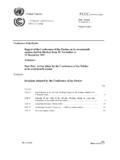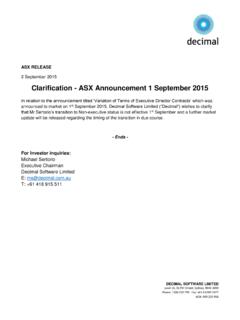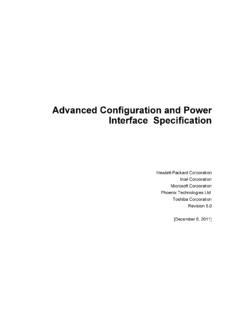Transcription of of health systems strengthening1 - WHO
1 Monitoring and evaluation of health systems strengthening1 An operational framework WHO, Geneva. November 2009 1 Paper prepared by WHO (Ties Boerma and Carla Abou Zahr), World Bank (Ed Bos), GAVI (Peter Hansen) and Global Fund (Eddie Addai and Daniel Low Beer) as part of the joint work on health systems strengthening and IHP+ common evaluation framework. Table of contents Summary .. 1 3 General principles ..3 A framework for M&E of health systems 6 Use of core indicators .. 6 Data 7 Data analysis and 8 Data dissemination, communication and 9 Operationalization of the framework .. 10 Country M&E 10 Global community of practice (CHeSS).. 11 Roles and responsibilities of global 12 Illustrative applications of the 14 Annexes A: IHP+ common evaluation 16 B: Illustrative examples of health systems monitoring indicator and data 17 C: Tools.
2 19 D: Use cases of the M&E framework for 21 Use case 1: Evaluation ..21 Use case 2: HSS joint programming .. 22 Use case 3: 23 Use case 4: 24 Use case 5: Performance based funding .. 25 Use case 6: E: Baseline assessement in 26 Monitoring and evaluation of health systems strengthening: An operational framework 1 Summary This paper presents a framework for monitoring and evaluation of health system strengthening (HSS) and discusses how it can be operationalized at the country level and how global partners can work together to support the implementation. Principles The framework builds upon principles derived from the Paris declaration on aid harmonization and effectiveness and the IHP+. The core is the strengthening of one country platform for monitoring and evaluation (M&E) of HSS. The framework is intended to be relevant for countries and for global health partnerships, donors, and agencies.
3 It will result in better alignment of country and global monitoring systems and can be used both for monitoring HSS joint programming as well as for tracking specific programmes. The results chain The framework shows how health inputs are reflected in outputs, outcomes and impact (Figure 1). system inputs, processes and outputs reflect health systems capacity, whereas outcomes and impact reflect health systems performance. The framework addresses indicator selection, related data sources, analysis and synthesis practices (including quality assessment), and communication and use. Based on existing work, indicators and data sources can be identified for each step in the results chain. HSS efforts should lead to measurable changes in health system inputs such as human and financial resources and measures of output such as levels and distribution of health service access and "readiness".
4 In turn, this should lead to results such as coverage of key interventions and improved health levels and equity. Figure 1 Monitoring & evaluation of health systems strengtheningInputs & processesOutputsOutcomesImpactData collectionIndicatordomainsAnalysis & synthesisCommunication & useImproved health outcomes & equitySocial and financial risk protectionResponsivenessEfficiencyFinanc ingInfrastructure; Information & communication technologiesHealth workforceSupply chainInformationInterventionaccess & services readinessInterventionquality, safetyCoverage of interventionsPrevalence risk behaviours & factorsGovernanceAdministrative sourcesFinancial tracking system ; NHAD atabases and records: HR, infrastructure, medicines dataFacility assessments Population based surveysCoverage, health status, equity, risk protection, responsivenessClinical reporting systemsService readiness, quality, coverage, health status Civil registrationData quality assessment; Estimates and projections; In depth studies; Use of research results; Assessment of progress and performance and efficiency of health systemsTargeted and comprehensive reporting; Regular country review processes; Global reporting Strategies for operationalizing the framework should meet three criteria: be primarily country focused but also offer the basis for global monitoring.
5 Address monitoring and evaluation needs for multiple users and purposes, including monitoring programme inputs, processes and results; tracking health systems performance; and evaluation; facilitate the identification of indicators and data sources, provide tools and guidance for data analysis, and show how the data can be communicated and used for decision making. Country M&E system The primary aim is to have a strong M&E system in place for the national health sector strategic plan that comprises all major disease programmes and health systems . The national M&E plan should address all components of the framework and lay the foundation for regular reviews during the implementation of the national plan. Existing country health sector review processes are key events to assess progress and performance.
6 The work on country M&E should generate the information needed for global monitoring while minimizing the reporting burden for countries. Monitoring and evaluation of health systems strengthening: An operational framework 2 Country operationalizaton A national country health systems surveillance (CHeSS) platform is needed to bring together the monitoring and evaluation work in disease specific programmes, such as TB, HIV/AIDS and immunization, with cross cutting efforts such as tracking human resources, logistics and procurement, and health service delivery (Figure 2). It also includes a contextual component that describes health systems in a systematic manner. The main goal of CHeSS is to improve the availability, quality and use of the data needed to inform country health sector reviews and planning processes, and to monitor health progress and system performance.
7 It is the platform for subnational, national and global reporting, aligning partners at country and global levels around a common approach to country support and reporting requirements. Figure 2 Country health systems Surveillance (CHeSS) platform Country data generation& compilationAnnual reviewsGlobal Fund reportingGAVI reportingMDG / UN reportingPEPFAR reportingProgrammeReporting ( TB, MCH, HIV/AIDS)Country data generation& compilationAnalysis & synthesisPerformanceassessmentStatistica lreportsProgrammereportsHarmonization of reporting requirementsMinimization of reporting requirementsExternal validation and estimatesCommon standards and toolsIndependentreviewsData qualityassessmentHSSJ ointProg. Roles of global partners Building on the IHP+ and H8 related work a global community of practice will aim to support the operationalization of the M&E framework through the CHeSS platform in countries through a community of practice using web enabled tools for information sharing and dissemination.
8 This will improve access to available data on key health indicators and on systems performance and will enable linking of statistical and broader contextual information. Partners will promote tools for data quality assessment, addressing data gaps, data analysis and for translating of data into policy relevant formats; multi country capacity building workshop and institutional capacity building. The multi purpose and multi directional orientation of the HSS M&E framework and its operational country platform supports the synthesis of data from multiple sources to inform annual health sector reviews, country planning processes, country management of health strategy and the tracking of progress made under global initiatives, such as HSS joint programming. It should also be used to better integrate M&E of specific programmes, such as immunization and HIV/AIDS into a national health information system .
9 Monitoring and evaluation of health systems strengthening: An operational framework 3 Background Recent substantial increases in international funding for health have been accompanied by increased demand for statistics to accurately track health progress and performance, evaluate impact, and ensure accountability at country and global levels. The use of results based financing mechanisms by major global donors has created further demand for timely and reliable data for decision making. There is increasing in country demand for data in the context of annual health sector reviews; this demand is also strong in countries that have established IHP+ compacts. However, on the supply side, there are major gaps in data availability and quality. Many developing countries face challenges in producing data of sufficient quality to permit the regular tracking of progress in scaling up health interventions and strengthening health systems .
10 Data gaps span the range of input, process, output, outcome and impact indicators. An increasing number of stakeholders, including global health partnerships, bilateral donors, UN agencies, and academic institutions are involved in health related monitoring and evaluation (M&E). Activities include the financing of strengthening monitoring and evaluation systems , and the development of frameworks, standards, tools and methods for data generation, collection, compilation, analysis and dissemination. Data are used to enable monitoring of progress towards targets, results based funding, and evaluation of large scale programmes. While these efforts have generally been linked to disease specific initiatives, there is growing interest in tracking the overall performance of country health systems , acknowledged to be pivotal to the achievement of the disease specific goals.

















